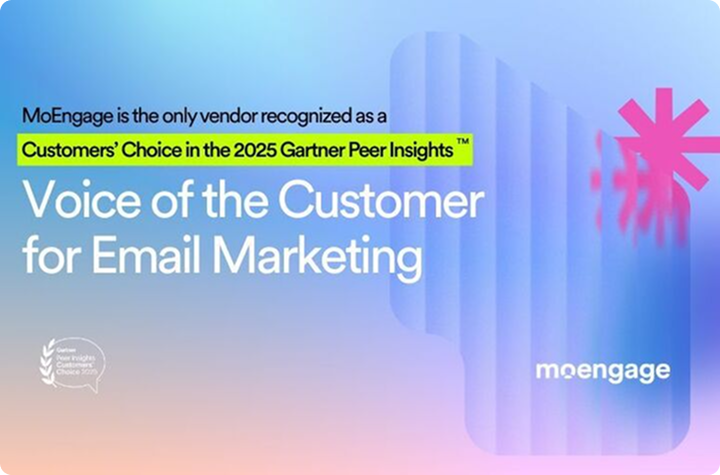Customer Engagement Deep Dive: How to Build Personalized Cross-Channel Journeys
Learn More
Is there a definite way to build engagement and brand loyalty? Does the paradox of unlimited choices confuse the consumer; or give them more options? What is the best technology to provide the product with an edge in the market?
The team at MoEngage debunk all of these questions in the conversation with Edward Killian, Sales and Marketing Officer Elevenia; Subir Lohan, Chief Growth Officer, DigiAsia; Fung Fuk: Product Officer, Cermati.
Here are some of the most prominent highlights:
A study by Columbia University gave a few consumers a choice between twenty-four types of jams. Another group experienced six varieties of jam. They noticed that the group with a higher number of options had a lower purchase rate.
This effect is called decision paralysis. It’s a situation where buyers face too many products in the market. This thought-overload keeps them from making any purchases at all. For an e-com company, the only way to tackle this problem is a cash-burn. Without suitable investments in outbound marketing, it’s hard to engage and retain users who seem burdened by choices.
The choice problem also causes buyer’s remorse. This is the feeling of a better option in the market after picking up a product. Fung Fuk from Cermati explains this with the example of jeans.
There was a time when the only jeans in the market were straight-cut. People would buy the jeans and go home knowing they got the right deal. Today’s choices are many, like boot cut, straight cut, slim cut, and much more. Although the user has a better chance of the right option, they often second guess the purchase.
To address this problem, companies can use the “80-20 rule.” It dictates that 80% of decisions are caused by 20% of the factors. So, the company focuses on high-impact 20% factors on making sales; rather than worry about the variable 80%.
Another way around the choice paradox is the use of customisation services. For example, in the case of an e-wallet, all users can own all accounts. However, in the B2B space, the clients could hold on to one wallet if customised to the market need.
“This is the best way to force-use products,” said Subir Lohan of DigiAsia.
One user behaviour we can confirm about the millennials is their love for deals and offers. But merely having sales will not retain users on the website. If you are looking to keep them on your platform, make it predictable and not sporadic.
Knowing a pattern of fixed discounts and offers will keep the users coming back for more. For example, the start of the money deals, weekend offers, etc., are excellent options for any service or product platform.
The millennials might be a significant market share, but many band-leaders do not just classify them as a segment.
Especially for a brand like finance or fintech, they have loans, insurance, credit card, and much more. The targeting must remain based on the needs and not just the generation. In such a case, using conventional ways like pay-per-click, search engine optimisation, search engine marketing, etc., are the ideal alternatives.
If you are a single product or a multiproduct platform, the most essential factor is transactions. This parameter is a clear indicator of the user’s retention and the only factor to emphasize.
Subir retakes the example of an e-wallet. The most annoying thing about a top-up wallet is you need to top-up. If the wallet remains empty, only a loyal user will go out of the way to top it up. They would also do so to avail a discount.
To fix this uncertainty, the team at DigiAsia started a buy-now-pay-later feature on the wallet. So based on their usage, they avail themselves of a pre-approved credit line. The user can shop on credit and then top-up the balance at their comfort and inevitably reduce the drop-off rate.
“Adjust the product to make them loyal, rather than give them a hard time,” Subir adds.
The use of machine leaving and artificial intelligence has become a norm in marketing today. Here are some simple use-cases that can derive the best result for an organization.
“The marketplace works on instant gratifications, so Gamification has a lot of potential,” says Fung Fuk from Cermati.
Gamification is the process of adding product integrations that allow users a game-play (like scoring points, leaderboards, game-play, etc.). This feature is added to the platform to enhance retention and provide rewards to the end-users.
Fung gives the example of a loan or credit-cards application form. This long, time-consuming, and tedious process. Instead of making it a task to fill five pages, they make it fun. The more data they submit, the more incentives are provided to the users.
The best way to keep relevant with the users is to be at the top of their minds. Edward gives the example of OLX. Many people ask the question, “is OLX still active?” That is because they do not need to spend on advertising because of the strong user base and need-based utility.
The best way to improve retention, engagement and break the choice paralysis — is by building very relevant brand equity with the right set of loyal users.
Be the first to access actionable reports, guides, tips, videos, podcasts from experts in Customer Engagement, retention and more!





MoEngage is an insights-led platform trusted by 1,350+ global brands like McAfee, Flipkart, Domino’s, Nestle, Deutsche Telekom, and more. MoEngage’s powerful analytics, personalization, and AI capabilities give a 360-degree view of your customers and help you create journeys across digital channels.
© Copyright 2025 MoEngage. All Rights Reserved.

Please wait while you are redirected to the right page...
